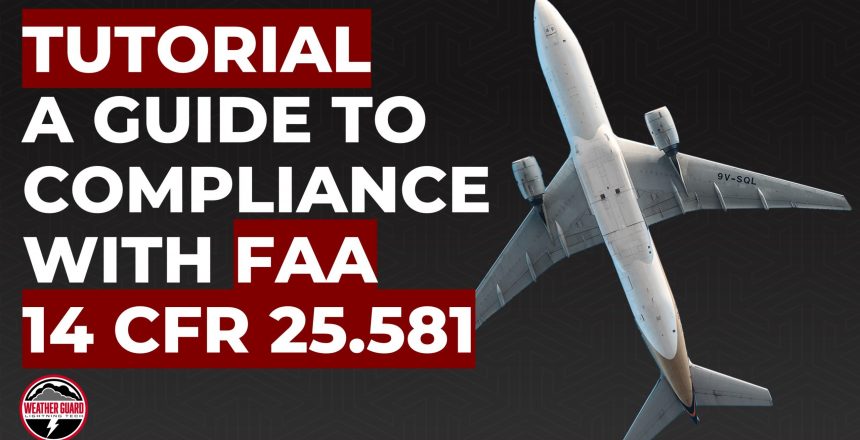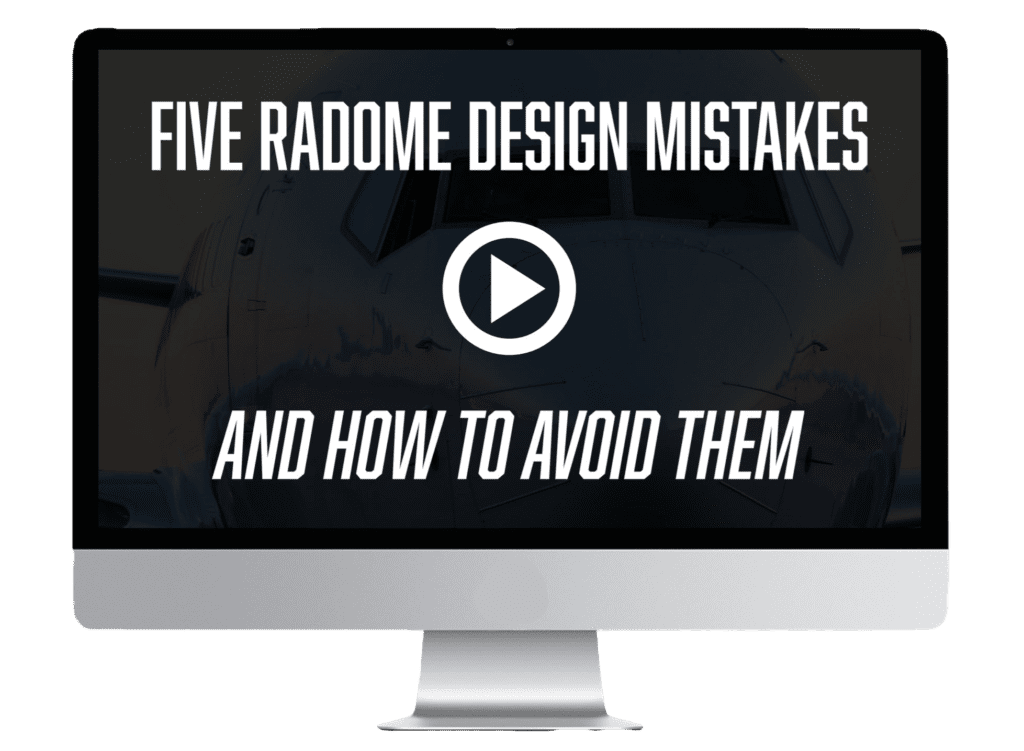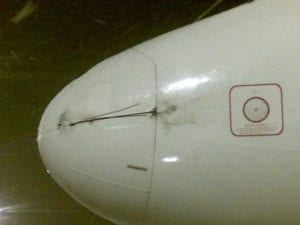In this tutorial we’re going to talk about compliance FAA regulation 14 CFR 25.581, which has to deal with aircraft structures of part 25 aircraft.
Watch Our Video on Compliance with FAA Regulation 14 CFR 25.581
This article is based on a transcript from the extremely clear and helpful guide created by Allen Hall, CEO of Weather Guard Lightning tech. Feel free to read this compliance guide–which contains all the presentation slides–or watch presentation below.
Quick Jump to Sections
- Watch Our Video on Compliance with FAA Regulation 14 CFR 25.581
- What Are Catastrophic Effects from Lightning?
- SAE Documents for Compliance
- Step 1: Defining Aircraft Lightning Strike Zones
- Step 2: Lightning Environment
- Step 3: Lightning Hazard Assessment
- Step 4: Design Protection for Metallic Components
- Step 5: Verify Compliance with FAA 25.581 Lightning Regulations
- Need Help with EASA CS 25.581 Regulations? We’ve Got You Covered.
- Aircraft Lightning Strike Protection Resources
- Questions on Your Radome Design or FAA Regulations?
What Are Catastrophic Effects from Lightning?
Now, catastrophic effects are obviously the loss of the aircraft and most likely of its crew and passengers. It’s very serious. This picture is from a lightning crash around 2003 where lightning struck the empennage and caused some problems in the flight control system. They were fortunate enough to get it back to the runway, but they still had a very serious accident.
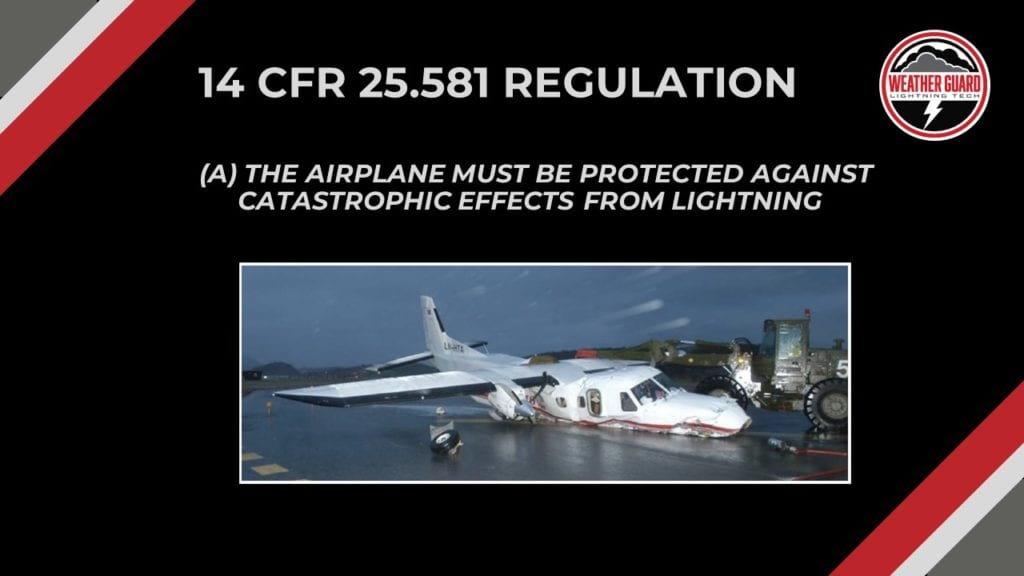
Lightning strike damage that results in this sort of catastrophic event is rare, but they still do exist. That means we, as the design engineers, need to be on top of this and make sure we’re doing the right things for compliance.
The Russian AeroFlot Flight 1492 crashed after a lightning strike and emergency landing in the fall of 2019. We talked about this crash on Struck, our audio and video podcast.
So let’s look at 25.581 regulation:
25.581 Lightning protection
(a) The airplane must be protected against catastrophic effects from lightning.
(b) For metallic components, compliance with paragraph (a) of this section may be shown by –
(1) Bonding the components properly to the airframe; or
(2) Designing the components so that a strike will not endanger the airplane.
(c) For nonmetallic components, compliance with paragraph (a) of this section may be shown by –
(1) Designing the components to minimize the effect of a strike; or
(2) Incorporating acceptable means of diverting the resulting electrical current so as not to endanger the airplane.
Now I give two examples here. One is a strike to a King Air wing, which wrinkled up the wing tip. The strike actually wrinkled parts of the wing and the fuselage so it’s a pretty strong lightning strike. And then a more common case here is a lightning strike to a rivet on an airplane where it just melts the head of the rivet.

So there’s kind of two extremes here, but in both cases, the design incorporated bonding and features that help minimize the effects of the strike. Right. So let’s go to part three of the regulation non-metallic components, C for non metallic components.
Compliance with paragraph a) of this section may be shown by minimizing the effect of a strike. And in this particular case, we show a carbon fiber wingtip that has incorporated metal foil on the outside to minimize the effects of a strike. That’s a very common design technique, putting some conductivity on the outside of a piece of carbon fiber structure to minimize the effects.
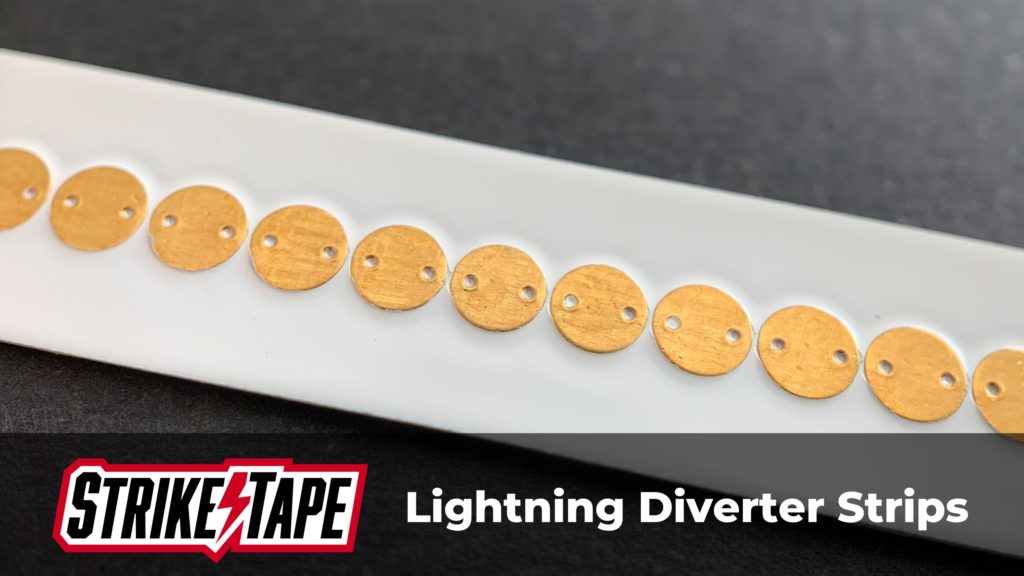
Part two of this regulation is incorporating accessible means of diverting the resulting electrical current so it won’t endanger the airplane.
Now in this particular case, what we see is a nose radome for an Airbus airplane. Nose radomes are typically made out of fiberglass or Kevlar, they’re non-conductive. And so in this particular case, what has been done, there’s a copper strip that’s applied to the outside of the radome to divert the current safely back to the airframe.
So, in both cases and minimizing the effect of a strike or in diverting it, when you get to talk about non metallic structure, components, those are really the two compliance methods that the regulation points out. So those are the three parts to the regulation.
SAE Documents for Compliance
Now let’s look at the document you’re gonna need. And there are four documents in which you’re gonna need to go get
ARP5577 – Aircraft Lightning Direct Effects Certification,
ARP 5414 Aircraft Lightning Zone,
ARP 5412 Aircraft Lightning Environment and Related Test Waveforms.
ARP 5416 Aircraft Lightning Test Methods.
All right, so those are the four documents. Now you can find those documents at www.sae.org online.
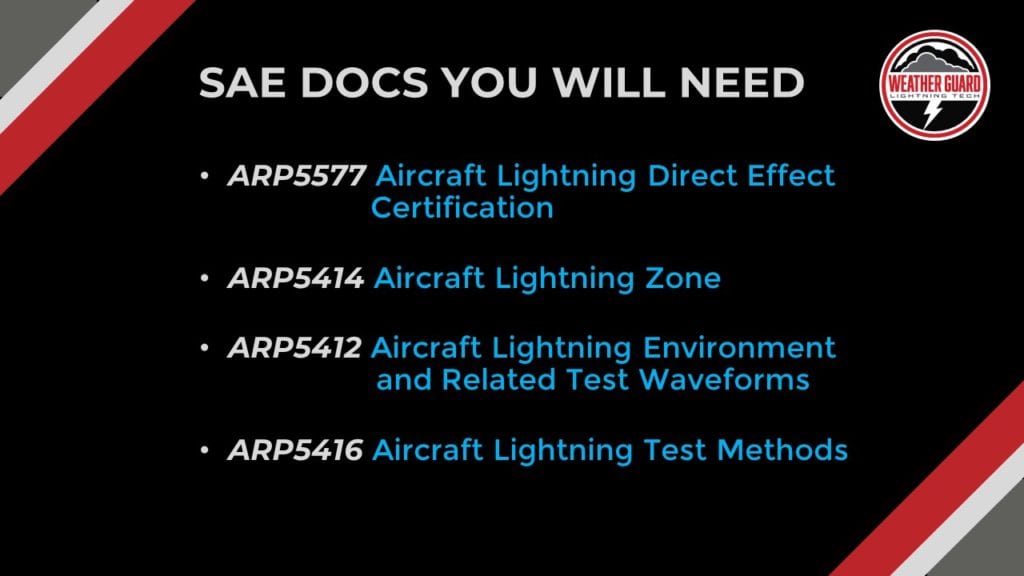
They do cost a couple of dollars to acquire, so you know you’re going to make an investment here. But you’re going to need all four of those documents as you’re dealing with 25.581.
Now we get down to the five steps to show a compliance.
Let’s walk through them. And they are described in general in ARP5577. I simplified them a little bit because I think ARP5577 can get a little bit complicated and it shouldn’t be that complicated. So one, we need to determine the lightning strike zones for the aircraft.
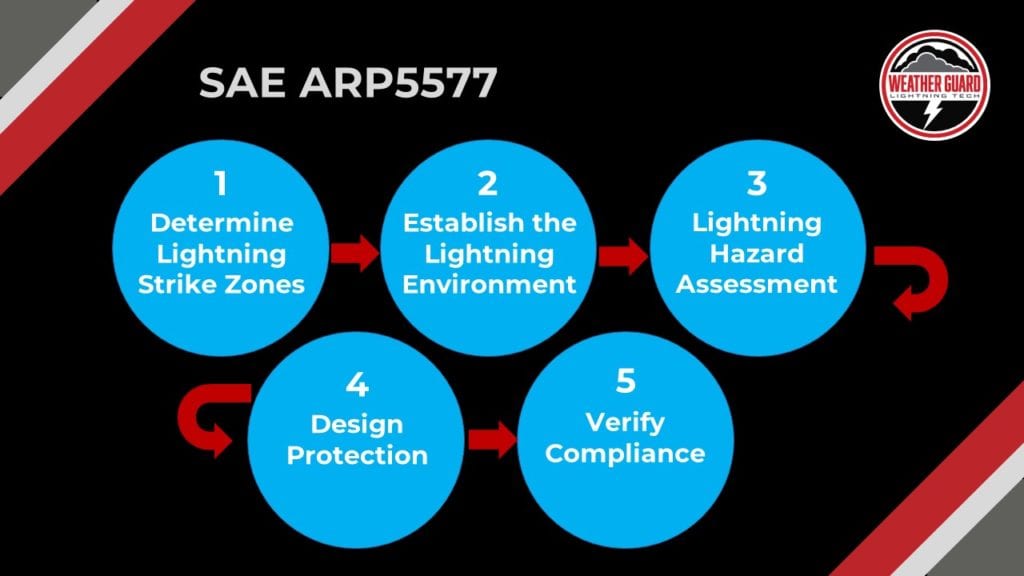
Next, we need to figure out where lightning is likely to attach to the airplane. Two – establish a lightning environment. So if lightning strikes a wingtip, how much energy is going to be applied to that?
Three, perform a lightning hazard assessment. We need to determine what the likely outcome of a lightning strike to a particular component to make sure that we understand what the implications are for the safety of the aircraft for we need to design protection. Figuring out which parts of the airplane may be vulnerable is crucial.
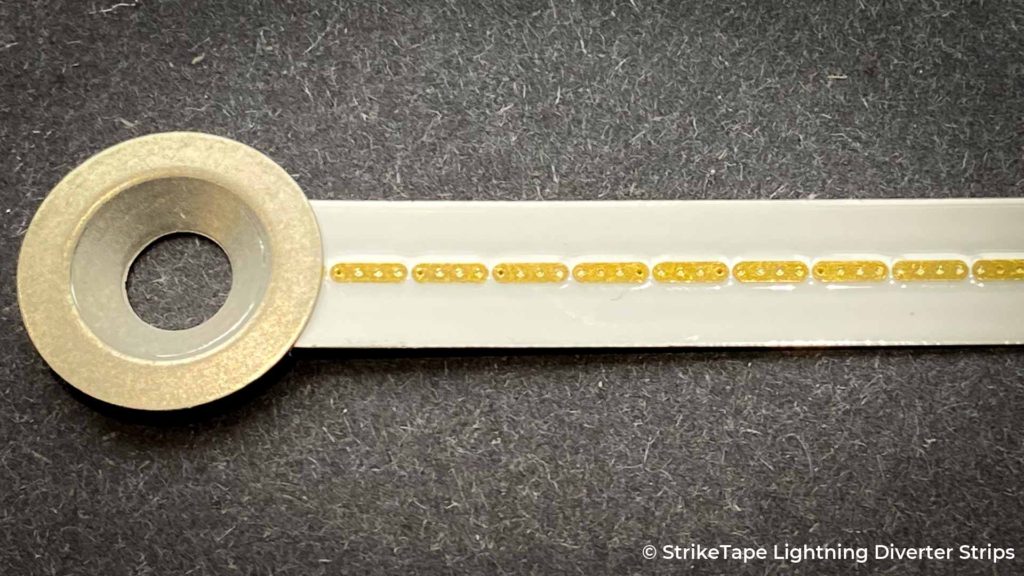
Four, we need to apply some sort of protection to the design of the part, and then the final step is verification.
That’s an overview of the five steps to compliance to FAA 14 CFR 25.581.
Step 1: Defining Aircraft Lightning Strike Zones
So step one of the five step process is lightning strike zones and defining what the lightning strike zones are for the aircraft. The place you need to go is ARP5414 – that’s going to define the aircraft zones for most aircraft. Now, just to simplify it a little bit, I broke it into the three basic zones:
- Lightning zone one
- Lightning zone two
- Lightning zone three.
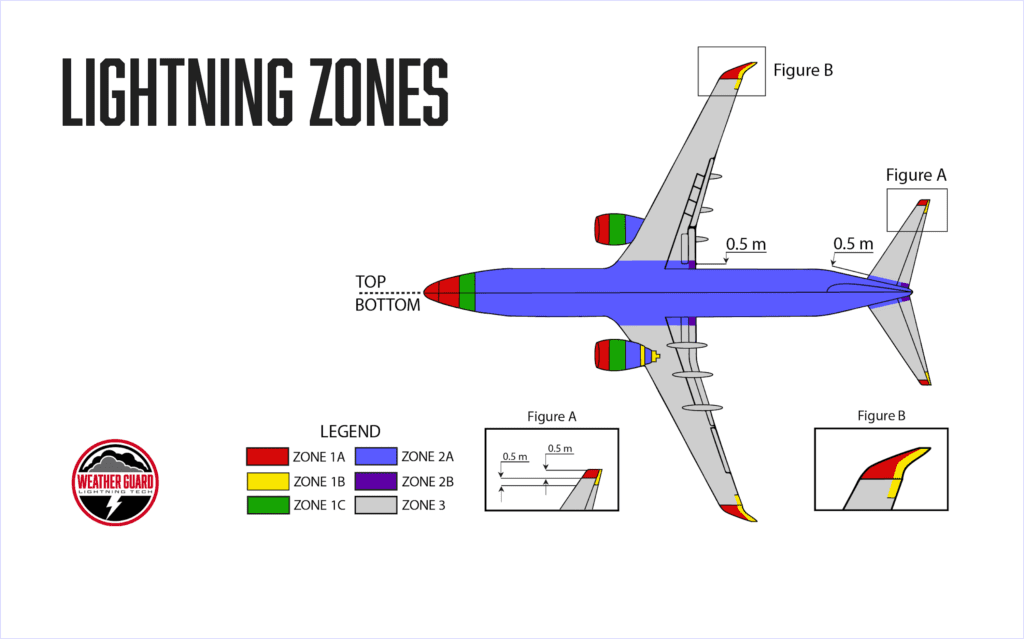
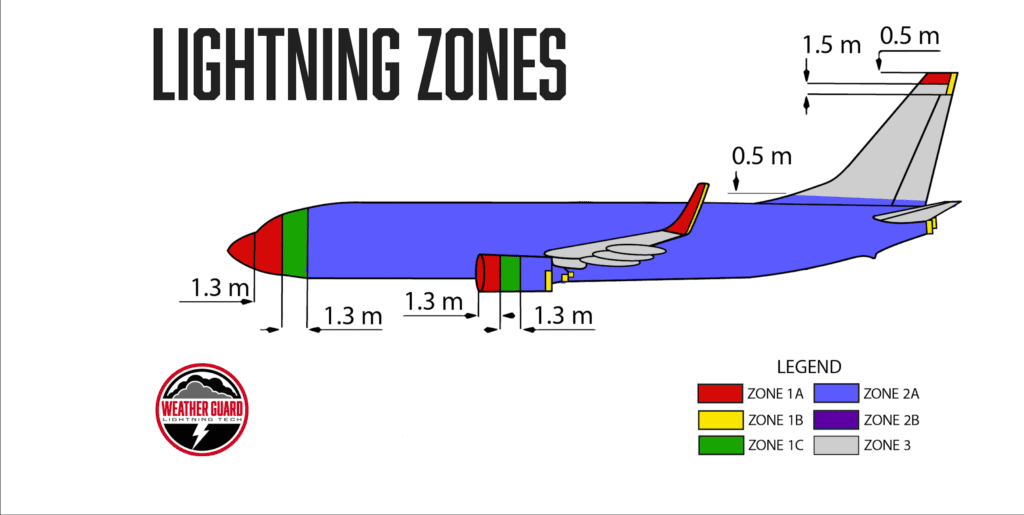
Zone 1: the extremities, the nose, the wing tips, the empennage tips.
Zone 2 tends to be the main body of the fuselage, parts of the wing, and then the empennage or tail.
Zone 3 is everywhere else, essentially–Big portions of the wing are in lightning zone 3; lightning zone 3 is a place where lightning is not likely to attach.
Zone 1 is where lightning is most likely going to initially attach. Zone 2 are the areas where lightning has a low likelihood of initial attachment, but lightning may still attach during the lightning event.
So, a strike to the nose as the aircraft moves forward–that strike will move down the fuselage. This means that the initial strike zone may have been the nose–which had been zone 1–but then the fuselage is in lightning zone 2. This shows how it can change because of the plane’s movement.
Step 2: Lightning Environment
Okay, so then we’re going to go to step two, which is looking at the lighting environment, defining the lightning environment – so that’s in ARP 5412. That associates the lightning zones with particular amounts of voltages and currents. Just to keep it simple here, for the purposes of this exercise zone 1 can experience up to 200,000 amps. Lightning zone 2 can experience 100,000 amps.
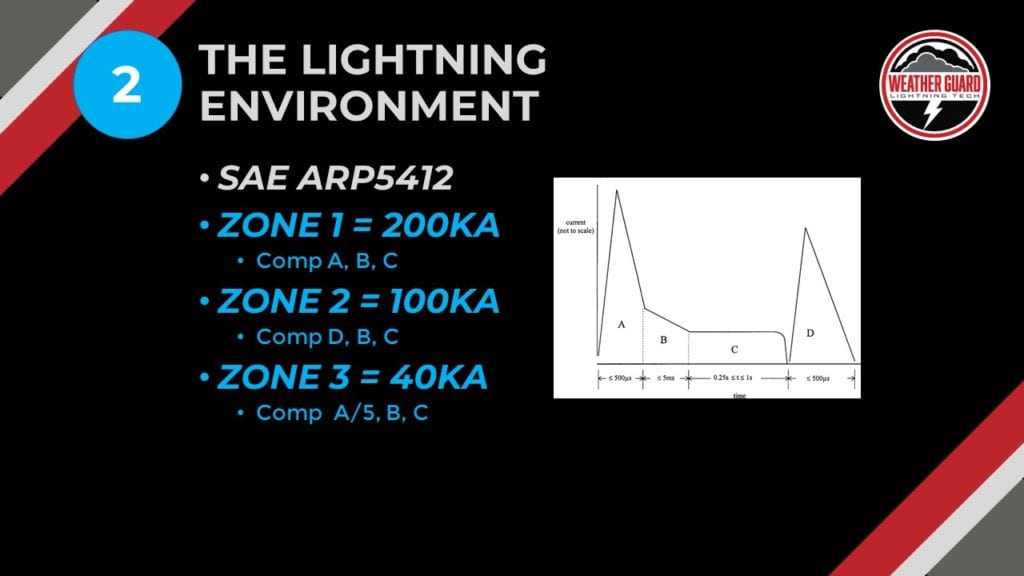
Unique and novel features in lightning zone 3, the SAE group recommends testing it to 40,000 amps. So those are the three generic levels. Just kind of get a relative sense of, of lightning. Zone 1 is 200,000 amps, Zone 2 is 100,000 amps, Lightning Zone 3 is 40,000 amps.
Step 3: Lightning Hazard Assessment
The third step is the lightning hazard assessment. And this is where you want to spend most of your time. So you want to do an evaluation of the potential lightning damage, and we’ll look at all aircraft structures, systems, and components.
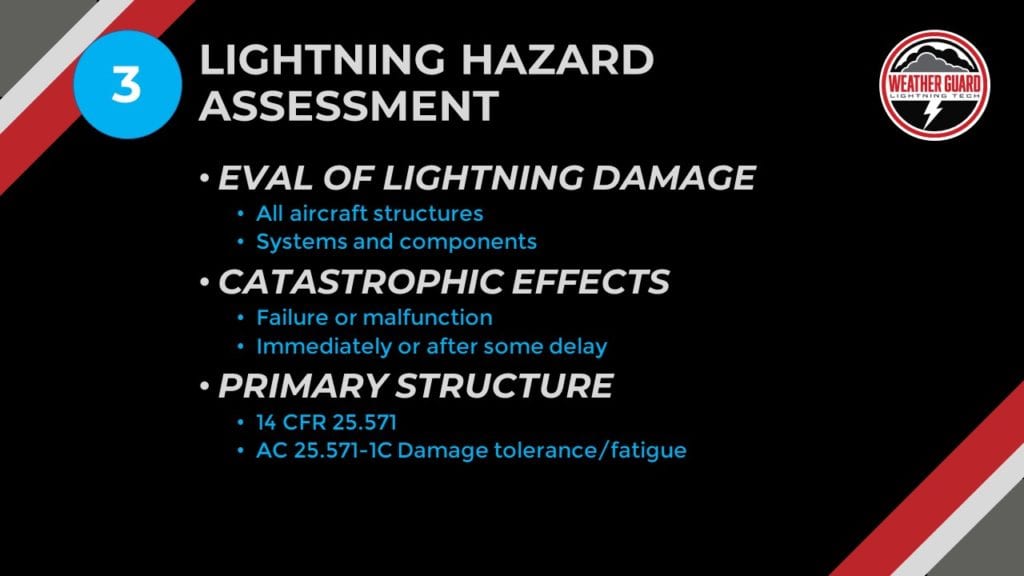
You will want to determine if there could be some sort of catastrophic effect, a failure or a malfunction, and it can happen immediately or after some delay. So for example, a strike to a wing tip could cause a wing tip to deform to the point where it bumps into an aileron and you may not notice it until later into flight.
Or, you have a strike to a flap and you don’t deploy the flaps until later in the flight. So you may not even know that the flap has been damaged so that the damage indication would not be immediate. The lightning effect may be noticed further down the flight profile.
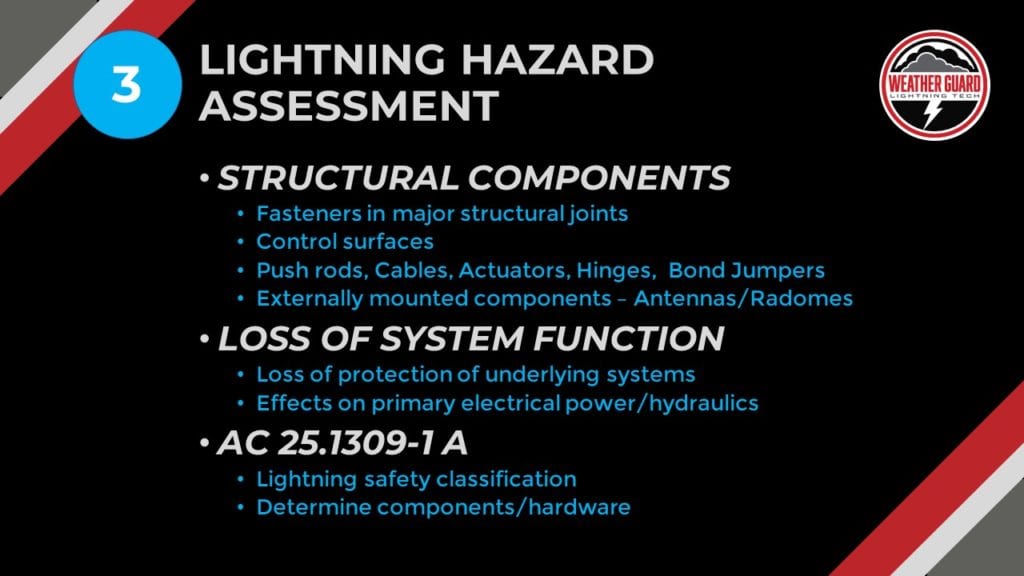
We’ll talk about some other areas we’re want look at, but the focus right now is primary structure for looking those things. If the primary structure took substantial lightning damage, it may cause the loss of the aircraft. So there’s two documents would look at which are free, 14 CFR 25.571 and the and the advisory circular that goes along with it AC 25.571-C which looks at damage tolerance and fatigue evaluation. So you want to do a little research and talk to your structures person. If you’re not a structured person, talk to a structures person about evaluating those structures.
And then you want to look at structural components. Now that could be faster at a major structural joints like a wing spar or a vertical stabilizer spar.
You will look at control surfaces, push rods, cables, actuator hinges, bond jumpers. Things that kind of bring structures together from an assembly, and then externally amount of components like antennas or radomes where if an antenna exploded from a lightning event, does it get sucked into an engine or do you have a radome that departs and hits the vertical stabilizer.
Pretty important to figure out ahead of time and determine how you want to protect them. Also, look at a loss of a system function, particularly mechanical systems. So the loss of protection of an underlying system because the outside has been struck.
So the simple case in points is an engine cowling that is protecting a FADEC, a full authority digital electronic control for an engine. If the cowling gets hit and the cowling comes apart, does that expose the underlying FADEC to things that it wouldn’t normally see. And then you also look at, you know, look at primary power – does the strike take out primary power. For example, a strike to a light on a wingtip takes out the aircraft power or a strike somewhere to a hydraulic tube that may be exposed on the trailing edge of an elevator. Does that cause you problems later on. Now the evaluation you’re going to do here is based on AC 25.1309-1A. We’re not saying you’re gonna do a 1309 analysis for lightning. That won’t happen, but the process is similar.
So you’ll hear engineers talk about doing a 1309 approach on lightning protection. What we’re saying is we’re going to follow the same guidelines in dthe guidance and how we think about what systems may be affected and what the consequences of damage or fear or failure of a component will have on the rest of the aircraft, on the safety of the aircraft. So we try to classify it and create a lightning safety classification system.
Step 4: Design Protection for Metallic Components
Step four, design protection for metallic components, right? So on a, on a metal part, what are we looking at in terms of a design protection? We want to know what that. Is the metal aluminum, steel or titanium. They’re all different resistances. They all respond differently to lightning energy.
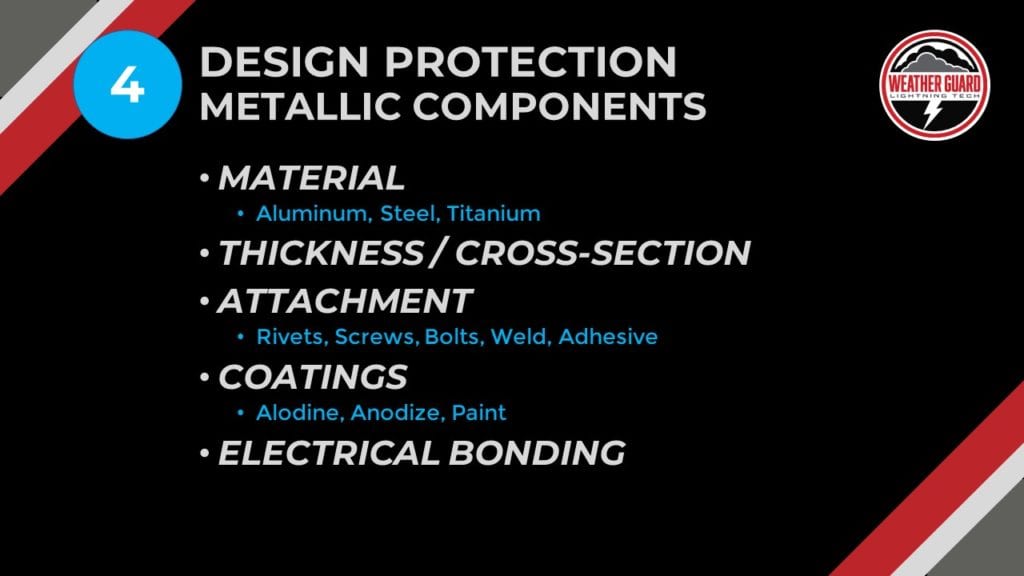
We are looking at the thickness and the cross sectional area. Is it thick enough to handle the lightning energy? We have to look at how it’s attached. If there’s two metal pieces that are stuck together or they rivited or are they screwed together, bolted or are they welded or adhesively bonded together?
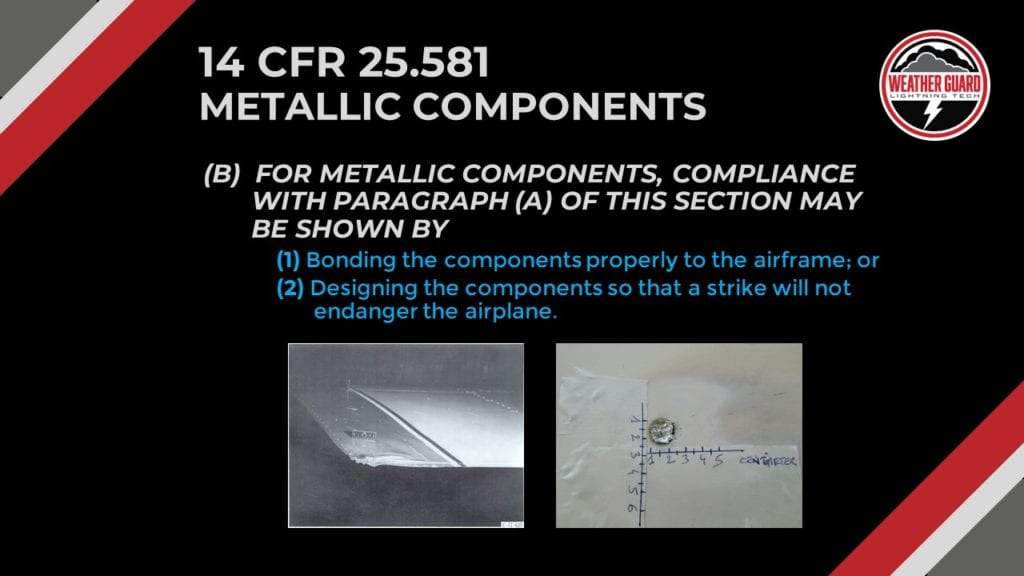
That has a big difference in terms of what the possible damage would be to those parts. We looking at coatings and electrical bonding – they kind of go together. Are the parts Alodined between them – so there’s a conductive coating between them? Or is the metal anodized or painted where there’s a non-conductive coating between them?
Non-conductive coatings tend to do more damage to a component during a lightening event because there’s not a dedicated path for lightning to travel. So lightning makes its own path and when it does, it causes a lot of extra damage.
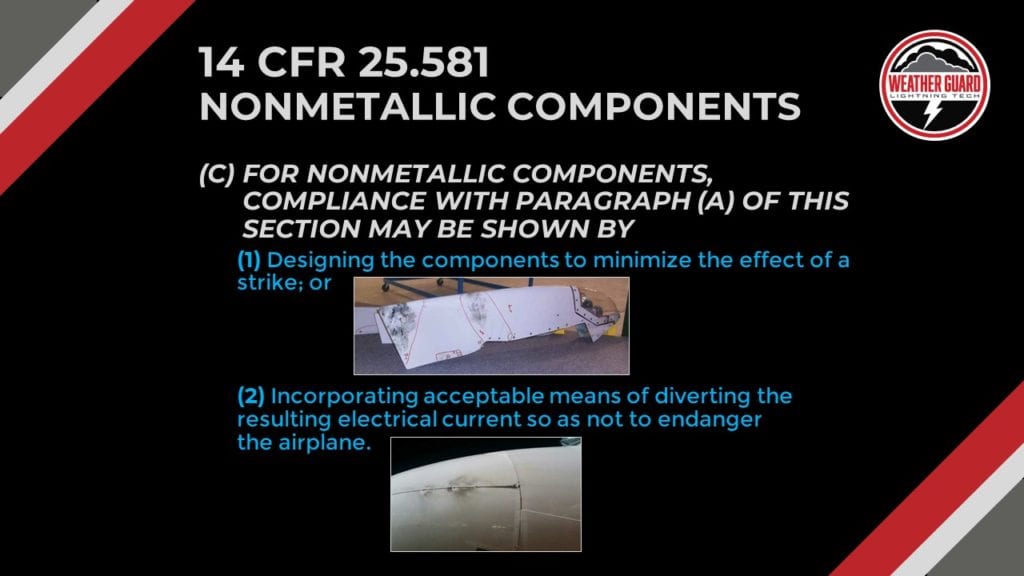
And then on the non-metallic components, we’re looking at similar things. What is the material? Is it carbon fiber? Fiberglass? How thick is it? Is it a 787 wing section or is it a, a much lighter cross sectional area that tend to be on a fairing where they tend to be very, very thin.
Metal foils – a lot of times metal foils are being used to protect composite structures, be it fiberglass or carbon fiber. Typical things were copper, bronze, aluminum, or even silver coatings, paint coatings – we’ve seen a lot more of that recently.
If you’re going to divert lightening energy – StrikeTape lightning diverters is a very common way to do that. And then we also want to look at how those composite parts are attached to one another. A lot of times it’s by a non-conductive adhesive or sometimes it’s some sort of screw or bolt or fastener that holds those parts together.
You can get a sense of what the likely damages will be and what’s at risk. If you burn out some fasteners, do you then not have enough structure to carry the load? Things you need to think about when you’re building carbon fiber or fiberglass parts.
Then, look at electrical bonding. There can be electrical bonding issues with non-conductive or highly resistive things like carbon fiber. You still want to make connections where you can to safely carry the lightning current.
Step 5: Verify Compliance with FAA 25.581 Lightning Regulations
Step five, which is probably the most expensive step of all, which is to verify compliance. So that’s primarily done with lightning testing. And the best thing to do that I, that I do, depending on where the customer is, is to just check Google and see what’s close.
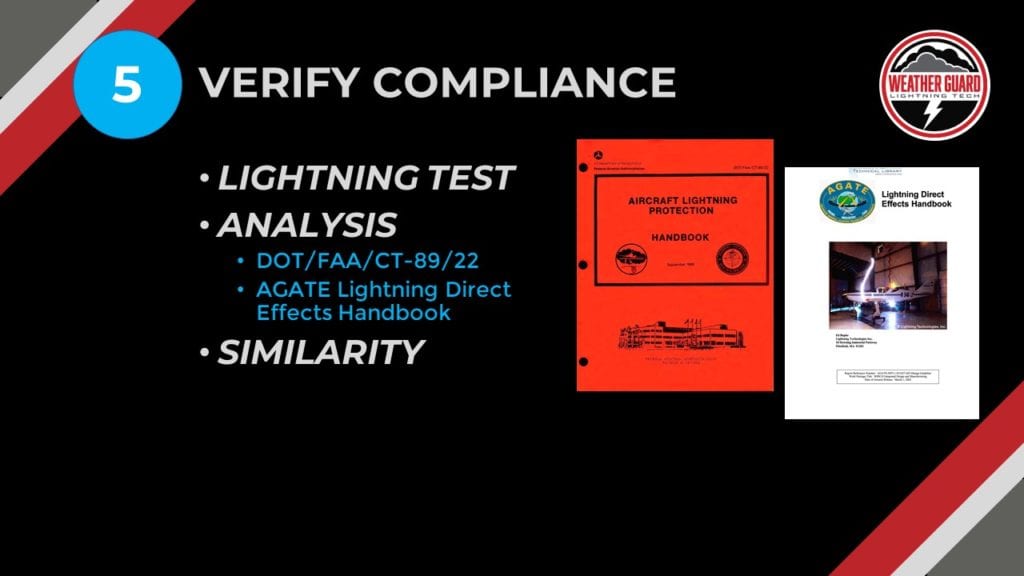
You’d like to get a lightning lab that’s competent and is relatively close to your facility. It just saves you a bunch of time travel. Google is the best way to look. There are lightning labs across the world. Finding one online is the best thing. I always find it building a relationship with a lightning lab is a good thing.
Analysis is another approach on metallic parts and some basic carbon fiber or fiberglass parts that have standard lightning protection.
There are really two documents you can use for FAA 14 CFR 25.581 certification that the FAA would allow you to use.
One is the DOT/ FAA/CT-89/22 which is the aircraft lightning protection handbook.
Two is the AGATE Lightning Direct Effects Handbook, which Ed Rupke put together from Lightning Technologies. That is a great handbook in the sense that Ed did a lot of testing on carbon fiber and fiberglass parts protected with a variety of very common lightning protection foils.
The last thing is similarity. A lot of companies, the bigger aircraft companies, like an Embraer or an Airbus or Boeing, even Cessna, Cirrus, where they have a lot of data already, would use similarity because they have test data as a foundation. Similarity gets used a lot for existing designs and parts that have been transferred from one aircraft model to another.
Need Help with EASA CS 25.581 Regulations? We’ve Got You Covered.
If you also need help with EASA CS 25.581, check out our tutorial below or read our EASA CS 25.581 guidance article here.
Aircraft Lightning Strike Protection Resources
- SAE ARP Lightning Guidance Material: What You Need to Know
- In this article, we discuss SAE ARP 5414B, 5412B and 5416A, which are crucial documents that every radome design engineer needs in their library
- SAE ARP Guidance Material Explained [Podcast]
- In this episode of the Struck Aerospace Engineering Podcast, FAA DER Allen Hall discusses the SAE ARP documents and explains what’s contained in each and why they’re important.
- EASA CS 25.581: The Guide to Compliance
- This article contains an accompanying video presentation that walks radome engineers through compliance with EASA CS 25.581, giving examples and steps to meeting the requirements.
- The Weather Guard Help Doc Center
- Visit our archive of historical lightning protection documents, crash reports, and articles on compliance, regulations and more.
Questions on Your Radome Design or FAA Regulations?
So those are the five steps. Definitely a little bit complicated, but totally manageable.
If you need help with your radome design, give us a call or send us an email today.

